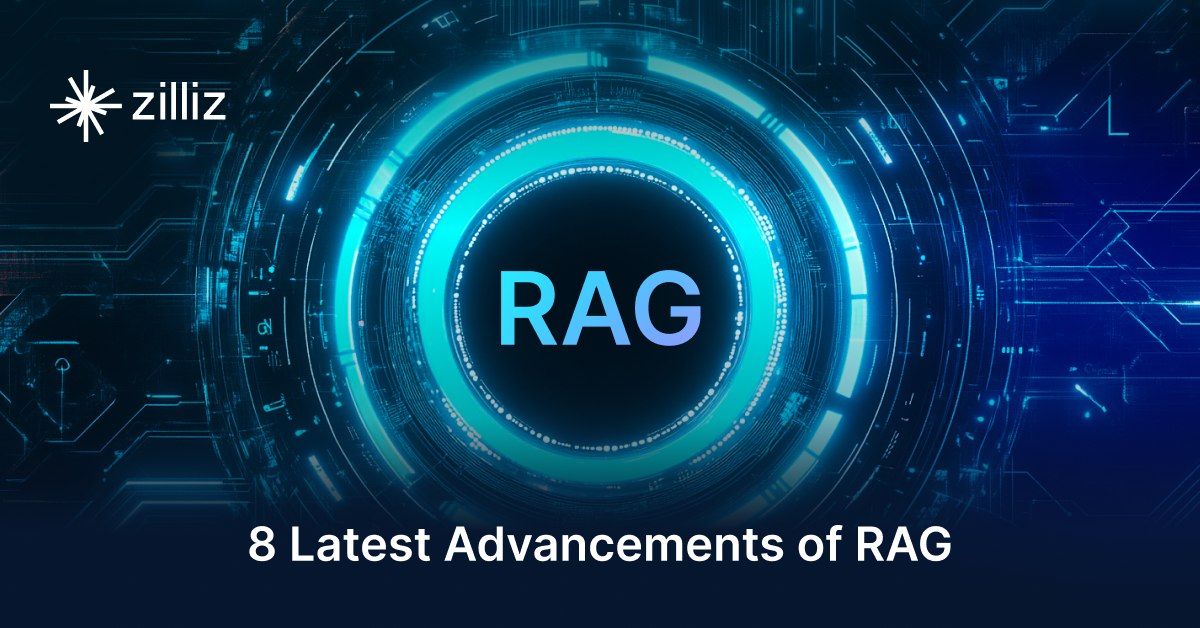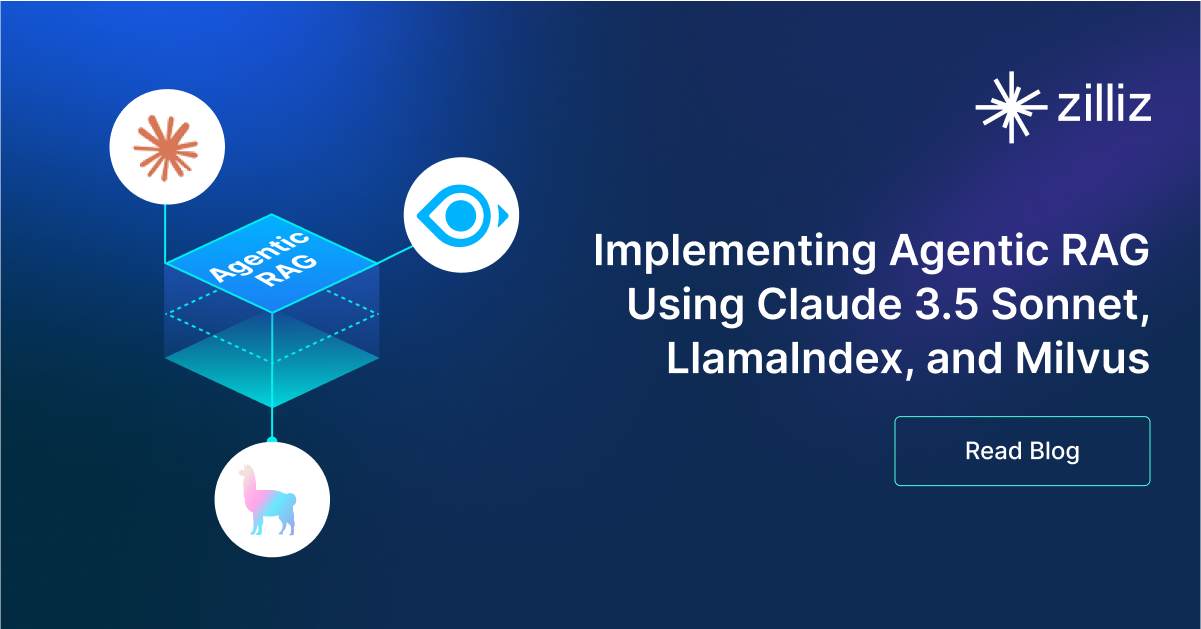Build RAG Chatbot with LangChain, Milvus, Fireworks AI Llama 3.1 70B Instruct, and Ollama bge-m3
Introduction to RAG
Retrieval-Augmented Generation (RAG) is a game-changer for GenAI applications, especially in conversational AI. It combines the power of pre-trained large language models (LLMs) like OpenAI’s GPT with external knowledge sources stored in vector databases such as Milvus and Zilliz Cloud, allowing for more accurate, contextually relevant, and up-to-date response generation. A RAG pipeline usually consists of four basic components: a vector database, an embedding model, an LLM, and a framework.
Key Components We'll Use for This RAG Chatbot
This tutorial shows you how to build a simple RAG chatbot in Python using the following components:
- LangChain: An open-source framework that helps you orchestrate the interaction between LLMs, vector stores, embedding models, etc, making it easier to integrate a RAG pipeline.
- Milvus: An open-source vector database optimized to store, index, and search large-scale vector embeddings efficiently, perfect for use cases like RAG, semantic search, and recommender systems. If you hate to manage your own infrastructure, we recommend using Zilliz Cloud, which is a fully managed vector database service built on Milvus and offers a free tier supporting up to 1 million vectors.
- Fireworks AI Llama 3.1 70B Instruct: This advanced model is designed for instruction-following tasks, featuring a vast 70 billion parameters for enhanced comprehension and context. It excels in generating coherent, contextually relevant outputs for complex queries, making it ideal for interactive applications, educational tools, and customer support systems requiring detailed and precise information.
- Ollama bge-m3: Ollama bge-m3 is a powerful language model designed for sophisticated natural language understanding and generation tasks. It excels in providing contextual responses, making it suitable for applications such as chatbots, content creation, and digital assistants, where conversational fluency and coherence are crucial.
By the end of this tutorial, you’ll have a functional chatbot capable of answering questions based on a custom knowledge base.
Note: Since we may use proprietary models in our tutorials, make sure you have the required API key beforehand.
Step 1: Install and Set Up LangChain
%pip install --quiet --upgrade langchain-text-splitters langchain-community langgraph
Step 2: Install and Set Up Fireworks AI Llama 3.1 70B Instruct
pip install -qU "langchain[fireworks]"
import getpass
import os
if not os.environ.get("FIREWORKS_API_KEY"):
os.environ["FIREWORKS_API_KEY"] = getpass.getpass("Enter API key for Fireworks AI: ")
from langchain.chat_models import init_chat_model
llm = init_chat_model("accounts/fireworks/models/llama-v3p1-70b-instruct", model_provider="fireworks")
Step 3: Install and Set Up Ollama bge-m3
pip install -qU langchain-ollama
from langchain_ollama import OllamaEmbeddings
embeddings = OllamaEmbeddings(model="bge-m3")
Step 4: Install and Set Up Milvus
pip install -qU langchain-milvus
from langchain_milvus import Milvus
vector_store = Milvus(embedding_function=embeddings)
Step 5: Build a RAG Chatbot
Now that you’ve set up all components, let’s start to build a simple chatbot. We’ll use the Milvus introduction doc as a private knowledge base. You can replace it with your own dataset to customize your RAG chatbot.
import bs4
from langchain import hub
from langchain_community.document_loaders import WebBaseLoader
from langchain_core.documents import Document
from langchain_text_splitters import RecursiveCharacterTextSplitter
from langgraph.graph import START, StateGraph
from typing_extensions import List, TypedDict
# Load and chunk contents of the blog
loader = WebBaseLoader(
web_paths=("https://milvus.io/docs/overview.md",),
bs_kwargs=dict(
parse_only=bs4.SoupStrainer(
class_=("doc-style doc-post-content")
)
),
)
docs = loader.load()
text_splitter = RecursiveCharacterTextSplitter(chunk_size=1000, chunk_overlap=200)
all_splits = text_splitter.split_documents(docs)
# Index chunks
_ = vector_store.add_documents(documents=all_splits)
# Define prompt for question-answering
prompt = hub.pull("rlm/rag-prompt")
# Define state for application
class State(TypedDict):
question: str
context: List[Document]
answer: str
# Define application steps
def retrieve(state: State):
retrieved_docs = vector_store.similarity_search(state["question"])
return {"context": retrieved_docs}
def generate(state: State):
docs_content = "\n\n".join(doc.page_content for doc in state["context"])
messages = prompt.invoke({"question": state["question"], "context": docs_content})
response = llm.invoke(messages)
return {"answer": response.content}
# Compile application and test
graph_builder = StateGraph(State).add_sequence([retrieve, generate])
graph_builder.add_edge(START, "retrieve")
graph = graph_builder.compile()
Test the Chatbot
Yeah! You've built your own chatbot. Let's ask the chatbot a question.
response = graph.invoke({"question": "What data types does Milvus support?"})
print(response["answer"])
Example Output
Milvus supports various data types including sparse vectors, binary vectors, JSON, and arrays. Additionally, it handles common numerical and character types, making it versatile for different data modeling needs. This allows users to manage unstructured or multi-modal data efficiently.
Optimization Tips
As you build your RAG system, optimization is key to ensuring peak performance and efficiency. While setting up the components is an essential first step, fine-tuning each one will help you create a solution that works even better and scales seamlessly. In this section, we’ll share some practical tips for optimizing all these components, giving you the edge to build smarter, faster, and more responsive RAG applications.
LangChain optimization tips
To optimize LangChain, focus on minimizing redundant operations in your workflow by structuring your chains and agents efficiently. Use caching to avoid repeated computations, speeding up your system, and experiment with modular design to ensure that components like models or databases can be easily swapped out. This will provide both flexibility and efficiency, allowing you to quickly scale your system without unnecessary delays or complications.
Milvus optimization tips
Milvus serves as a highly efficient vector database, critical for retrieval tasks in a RAG system. To optimize its performance, ensure that indexes are properly built to balance speed and accuracy; consider utilizing HNSW (Hierarchical Navigable Small World) for efficient nearest neighbor search where response time is crucial. Partitioning data based on usage patterns can enhance query performance and reduce load times, enabling better scalability. Regularly monitor and adjust cache settings based on query frequency to avoid latency during data retrieval. Employ batch processing for vector insertions, which can minimize database lock contention and enhance overall throughput. Additionally, fine-tune the model parameters by experimenting with the dimensionality of the vectors; higher dimensions can improve retrieval accuracy but may increase search time, necessitating a balance tailored to your specific use case and hardware infrastructure.
Fireworks AI Llama 3.1 70B Instruct optimization tips
Llama 3.1 70B Instruct is a powerful model with a balance of speed and reasoning capabilities. Enhance retrieval performance by using hybrid search methods that incorporate both semantic and keyword-based matching. Keep prompts structured with clear sections, ensuring optimal focus on key information. Set temperature between 0.1 and 0.3, fine-tuning top-k and top-p values to control output variability. Implement caching strategies for frequently used queries to optimize cost and efficiency. Fireworks AI's auto-scaling capabilities allow for dynamic resource allocation—use this to handle peak workloads effectively. Streaming responses can improve user experience for real-time applications. If deploying 70B alongside larger models, use it as an intermediate option for moderately complex queries while reserving the largest models for deep analytical reasoning.
Ollama bge-m3 optimization tips
To optimize the Ollama bge-m3 component in a Retrieval-Augmented Generation setup, consider implementing a well-defined caching strategy for frequently accessed data, which will significantly reduce response times and improve overall latency. Additionally, fine-tune your query relevance by adjusting the parameters for the retrieval model to maximize quality, leveraging embeddings for context enrichment. Batch processing of queries can further improve throughput. Lastly, monitor performance metrics continuously to identify bottlenecks and make data-driven adjustments, ensuring robust scalability and responsiveness in production environments.
By implementing these tips across your components, you'll be able to enhance the performance and functionality of your RAG system, ensuring it’s optimized for both speed and accuracy. Keep testing, iterating, and refining your setup to stay ahead in the ever-evolving world of AI development.
RAG Cost Calculator: A Free Tool to Calculate Your Cost in Seconds
Estimating the cost of a Retrieval-Augmented Generation (RAG) pipeline involves analyzing expenses across vector storage, compute resources, and API usage. Key cost drivers include vector database queries, embedding generation, and LLM inference.
RAG Cost Calculator is a free tool that quickly estimates the cost of building a RAG pipeline, including chunking, embedding, vector storage/search, and LLM generation. It also helps you identify cost-saving opportunities and achieve up to 10x cost reduction on vector databases with the serverless option.
 Calculate your RAG cost
Calculate your RAG cost
What Have You Learned?
By diving into this tutorial, you’ve unlocked the power of combining cutting-edge tools to build a RAG system that’s both intelligent and efficient! You learned how LangChain acts as the glue, seamlessly orchestrating workflows between components like a pro. Milvus, your high-performance vector database, stepped in to handle the heavy lifting of storing and retrieving embeddings at scale, ensuring lightning-fast similarity searches. Then came Fireworks AI’s Llama 3.1 70B Instruct, the LLM powerhouse that transforms retrieved context into human-like, insightful responses—like having a genius collaborator on your team. And let’s not forget Ollama’s bge-m3 embedding model, which turned raw text into rich numerical representations, making every query and document speak the language of vectors. Together, these tools formed a dynamic pipeline where data flows from ingestion to insight, proving how modular and customizable RAG systems can be!
But you didn’t just stop at the basics—you explored optimization tricks to fine-tune performance, like tweaking chunk sizes for better retrieval or adjusting temperature settings for more creative outputs. Plus, that free RAG cost calculator gave you a superpower: predicting expenses before deployment, so you can scale smartly without surprises. Now, imagine what’s next! You’ve got the blueprint to build systems that answer questions, summarize content, or even brainstorm ideas—all while staying cost-effective and responsive. The world of AI is your playground, and you’re equipped with the tools to innovate. So go ahead—experiment, iterate, and create something amazing. Your next RAG project isn’t just a possibility; it’s a guarantee. Let’s build the future, one retrieval-augmented answer at a time! 🚀
Further Resources
🌟 In addition to this RAG tutorial, unleash your full potential with these incredible resources to level up your RAG skills.
- How to Build a Multimodal RAG | Documentation
- How to Enhance the Performance of Your RAG Pipeline
- Graph RAG with Milvus | Documentation
- How to Evaluate RAG Applications - Zilliz Learn
- Generative AI Resource Hub | Zilliz
We'd Love to Hear What You Think!
We’d love to hear your thoughts! 🌟 Leave your questions or comments below or join our vibrant Milvus Discord community to share your experiences, ask questions, or connect with thousands of AI enthusiasts. Your journey matters to us!
If you like this tutorial, show your support by giving our Milvus GitHub repo a star ⭐—it means the world to us and inspires us to keep creating! 💖
- Introduction to RAG
- Key Components We'll Use for This RAG Chatbot
- Step 1: Install and Set Up LangChain
- Step 2: Install and Set Up Fireworks AI Llama 3.1 70B Instruct
- Step 3: Install and Set Up Ollama bge-m3
- Step 4: Install and Set Up Milvus
- Step 5: Build a RAG Chatbot
- Optimization Tips
- RAG Cost Calculator: A Free Tool to Calculate Your Cost in Seconds
- What Have You Learned?
- Further Resources
- We'd Love to Hear What You Think!
Content
Vector Database at Scale
Zilliz Cloud is a fully-managed vector database built for scale, perfect for your RAG apps.
Try Zilliz Cloud for Free


